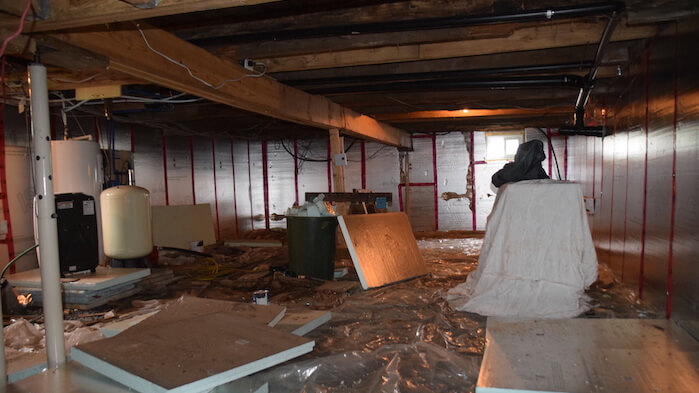The term “out of sight, out of mind” commonly applies to several areas of a house including roofs, attics and crawl spaces, which are often ignored for long periods of time. When access is limited or non-existent, crawl spaces may be ignored indefinitely. However, this can be detrimental. In areas of high moisture levels, wood components within a crawl space are susceptible to structural damage due to rot. Additionally, insect and vermin activity can go unnoticed.
 A crawl space is the below grade area of a home that is bound by the building’s foundations. Like basements, crawl spaces are the biproduct of a structure’s need to have its footings below the frost line. Unlike basements, crawl spaces are often unfinished and unutilized. Historically, crawl spaces were common in older constructions, where only shallow excavated trenches were made to place footings just beneath the frost line. Basements on the other hand generally have deeper excavations and require removal of all the soil beneath the structure. In more recent constructions, crawl spaces are commonly provided as alternatives to basements as a cost saving strategy, or in locations where basements are not desired or favoured.
A crawl space is the below grade area of a home that is bound by the building’s foundations. Like basements, crawl spaces are the biproduct of a structure’s need to have its footings below the frost line. Unlike basements, crawl spaces are often unfinished and unutilized. Historically, crawl spaces were common in older constructions, where only shallow excavated trenches were made to place footings just beneath the frost line. Basements on the other hand generally have deeper excavations and require removal of all the soil beneath the structure. In more recent constructions, crawl spaces are commonly provided as alternatives to basements as a cost saving strategy, or in locations where basements are not desired or favoured.
Not all crawl spaces are created equal; whether it be a poor initial design characteristic or a previous home improvement project, combining the wrong construction practices and principles may contribute to premature deterioration within a crawl space. Crawl spaces may have dirt floors or include a concrete slab. Modern codes require crawl spaces to have a minimum 36-inch (915 mm) clearance and be accessible; however older crawlspaces may have less clearance and be inaccessible. According to some modern codes, a basement with a clearance less than 70 inches (1,800 mm) is defined as a crawl space. While some crawl spaces are heated, others are not. In an attempt to maintain a moisture free space to prevent conditions that favour wood rot, some crawl spaces are ventilated. However, this commonly results in thermal discomfort to the occupants on the floor above the crawlspace because it creates cold surfaces.
Various strategies are often attempted to manage crawlspace environments; it is not uncommon for conflicting strategies to be incorrectly applied at once. Rather than solving existing issues, they create new ones. Understanding the catalyst of these issues is imperative when faced with a crawl space related property damage claim. Below are some general guidelines for a healthy crawl space.
Conditioning:
Crawl spaces can be conditioned (heated) or unconditioned. Conditioned crawl spaces often contribute to warming of the floor finish above, which increases thermal comfort of the occupants. While it is acceptable for crawl spaces to be unconditioned, in the event of insufficient footing depth and extreme cold, there is risk of foundation damage due to ground frost.
Ventilation:
Some modern codes and standards require that unheated crawl spaces be ventilated, similarly to attic spaces. The reason for this is to help remove potential moisture from the air, which can contribute to premature degradation of the building structure (i.e., rot). In limited cases, elevated moisture levels within the crawl space may also have adverse effects on the indoor air quality and contribute to occupant discomfort. A ventilation rate of 1:500 is a common ratio, where 1 square unit of ventilation is required for every 500 square units of crawl space floor area.
Insulation:
Canadian winter weather is what drives our need to insulate conditioned spaces. Within crawl spaces, options are to either insulate the underside of the floor structure above or insulate the crawl space walls. The former is commonly done when ventilating an unconditioned crawl space. This option commonly results in thermal discomfort for the occupants, as even when properly insulated, the floor above an unconditioned space inherently feels cool. The latter option of insulating the walls is generally done when the crawl space is not vented. In these instances, heating the space is generally required by modern standards.
Floor Cover:
Historically, crawl spaces had dirt floors, however this configuration can lead to increased levels of moisture entering the crawl space through the soil. There is also risk of vermin accessing and infesting the space through burrows in the ground. While placing a polyethylene sheet (vapour retarder) on the ground helps limit moisture entry within the space, it does not prevent some infestations. Pouring a concrete slab over the vapour retarder helps with moisture and certain vermin issues.
Several factors can lead to property damage claims associated with crawl spaces. These include implementing the wrong management strategies with one another, lack of maintenance, environmental factors or even a renovation gone wrong. Knowing when to ventilate and how to insulate a crawl space can make a difference. The experts at CEP Forensic can assist in determining specific causes of damage unique to crawl spaces and recommend practical repair strategies.
